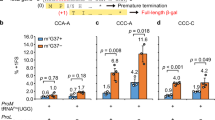Summary
The structural gene for theBacillus stearothermophilus initiation factor IF2 was localized to a 6 kbHindIII restriction fragment by cross-hybridization with theSstI-SmaI fragment of theEscherichia coli infB gene. This fragment corresponds to the central region of the molecule containing the GTP-binding domain which is homologous inE. coli IF2, EF-Tu, EF-G and the humanras1 oncogene protein. After cloning into pACYC177, theHindIII fragment was further analysed by restriction mapping and cross-hybridization. A smaller (2.2 kb)SphI-HindIII fragment, which showed cross-hybridization, was subcloned into M13 phage and sequenced by the dideoxy chain-terminating method. This fragment was found to contain the entire IF2 gene except for the region coding for the N-terminus. This remaining region, coding for 45 amino acids, was located by homologous hybridization on an overlappingClaI-SstI fragment which was also subcloned and sequenced. Overall, theB. stearothermophilus IF2 gene codes for a protein of 742 amino acids (Mr=82,043) whose primary sequence displays extensive homology with the C-terminal two-thirds (but little or no homology with the N-terminal one-third) of the correspondingE. coli IF2 molecule. When cloned into an expression vector under the control of the λPL promoter, theB. stearothermophilus IF2 gene, reconstituted by ligation of the two separately cloned pieces, could be expressed at high levels inE. coli cells.
Similar content being viewed by others
References
Atkins JF (1979) Is UAA or UGA part of the recognition signal for ribosomal initiation? Nucleic Acids Res 7:1035–1041
Chang ACY, Cohen SN (1978) Construction and characterization of amplifiable multicopy DNA cloning vehicles derived from the P15A cryptic miniplasmid. J Bacteriol 134:1141–1156
Gold L, Pribnow D, Schneider T, Shinedling S, Swebilius Singer B, Stormo G (1981) Translational initiation in prokaryotes. Annu Rev Microbiol 35:365–403
Gualerzi C, Pon CL, Pawlik RT, Canonaco MA, Paci M, Wintermeyer W (1986) Role of the initiation factors inEscherichia coli translational initiation. In: Hardesty B, Kramer G (eds) Structure, function and genetics of ribosomes. Springer, New York Berlin Heidelberg, pp 621–641
Hager PW, Rabinowitz JC (1985) Translational specificity inBacillus subtilis. In: Dubnau DA (ed) The molecular biology of the Bacilli, vol. II. Academic Press, New York, pp 1–32
Jurnak F (1985) Structure of the GDP domain of EF-Tu and location of the amino acids homologous toras oncogene proteins. Science 230:32–36
Kimura M, Ernst H, Appelt K (1983) The primary structure of initiation factor IF3 fromBacillus stearothermophilus. FEBS Lett 160:78–81
Kimura M, Kimura J, Watanabe K (1985) The primary structure of ribosomal protein L2 fromBacillus stearothermophilus. Eur J Biochem 153:289–297
Maniatis T, Fritsch EF, Sambrook J (1982) Molecular cloning. A laboratory manual. Cold Spring Harbor Laboratory Press, New York
March PE, Inouye M (1985) GTP binding membrane protein ofEscherichia coli with sequence homology to initiation factor 2 and elongation factors Tu and G. Proc Natl Acad Sci USA 82:7500–7804
Messing J (1983) New M13 vectors for cloning. Methods Enzymol 101:20–78
Mosely SL, Falkow S (1980) Nucleotide sequence homology between the heat-labile enterotoxin gene ofEscherichia coli andVibrio cholerae deoxyribonucleic acid. J Bacteriol 144:444–446
Nakamura Y, Mizusawa S (1985) In vivo evidence that the nusA and infB genes ofE. coli are part of the same multi-gene operon which encodes at least four proteins. EMBO J 4:527–532
O'Farrell PH, Kutter E, Nakanishi M (1980) A restriction map of the bacteriophage T4 genome. Mol Gen Genet 179:421–435
Pawlik RT, Littlechild J, Pon C, Gualerzi C (1981) Purification and properties ofEscherichia coli translational initiation factors. Biochem Int 2:421–428
Pon CL, Paci M, Pawlik RT, Gualerzi CO (1985) Biochemical and biophysical characterization of the interaction between IF2 and guanosine nucleotides. J Biol Chem 260:8918–8924
Remaut E, Stanssens P, Fiers W (1981) Plasmid vectors for high efficiency expression controlled by the PL promoter of coliphage lambda. Gene 15:81–93
Sacerdot C, Dessen P, Hershey JWB, Plumbridge JA, Grunberg-Manago M (1984) Sequence of the IF2 gene: unusual protein features and homologies with elongation factors. Proc Natl Acad Sci USA 81:7787–7791
Sanger F, Coulson AR, Barrell BG, Smith AJH, Roe BA (1980) Cloning in single-stranded bacteriophage as an aid to rapid DNA sequencing. J Mol Biol 143:161–178
Smith MG (1967) Isolation of high molecular weight DNA from normal and phage-infectedEscherichia coli. Methods Enzymol 12:545–550
Southern EM (1975) Detection of specific sequences among DNA fragments separated by gel electrophoresis. J Mol Biol 98:503–517
Travers AA, Debenham PG, Pongs O (1980) Translation initiation factor 2 alters transcriptional selectivity ofEscherichia coli ribonucleic acid polymerase. Biochemistry 19:1651–1656
Vieira J, Messing J (1982) The pUC plasmids, an M13mp7-derived system for insertion mutagenesis and sequencing with synthetic universal primers. Gene 19:259–268
Wintermeyer W, Gualerzi C (1983) Effect ofE. coli initiation factors on the kinetics of N-AcPhe-tRNAPhe binding to 30 S ribosomal subunits. A fluorescence stopped-flow study. Biochemistry 22:690–694
Author information
Authors and Affiliations
Additional information
Communicated by A. Böck
Rights and permissions
About this article
Cite this article
Brombach, M., Gualerzi, C.O., Nakamura, Y. et al. Molecular cloning and sequence of theBacillus stearothermophilus translational initiation factor IF2 gene. Molec. Gen. Genet. 205, 97–102 (1986). https://doi.org/10.1007/BF02428037
Received:
Issue Date:
DOI: https://doi.org/10.1007/BF02428037




